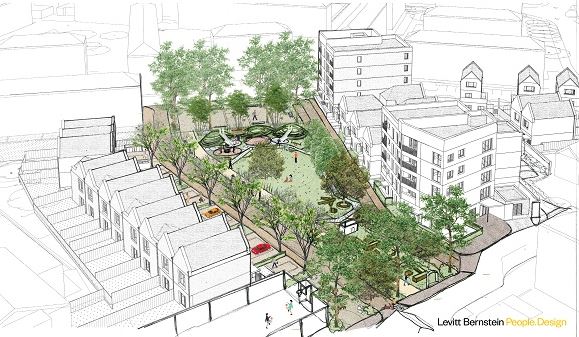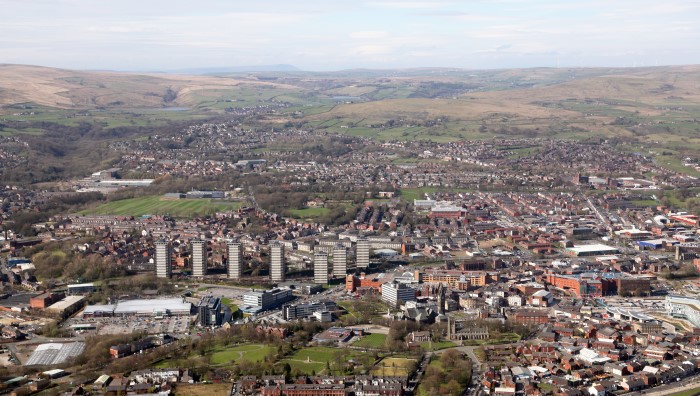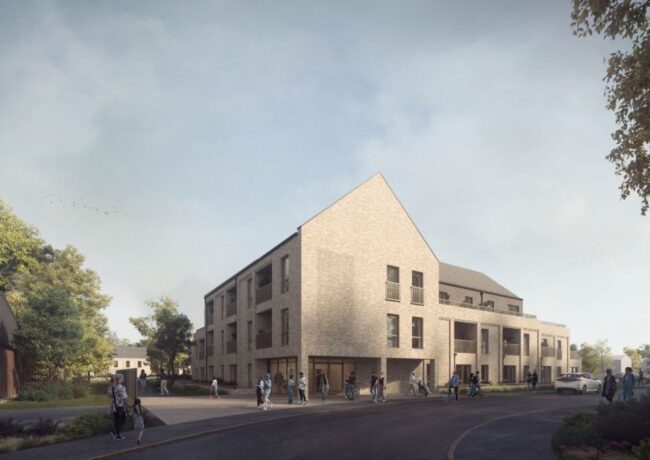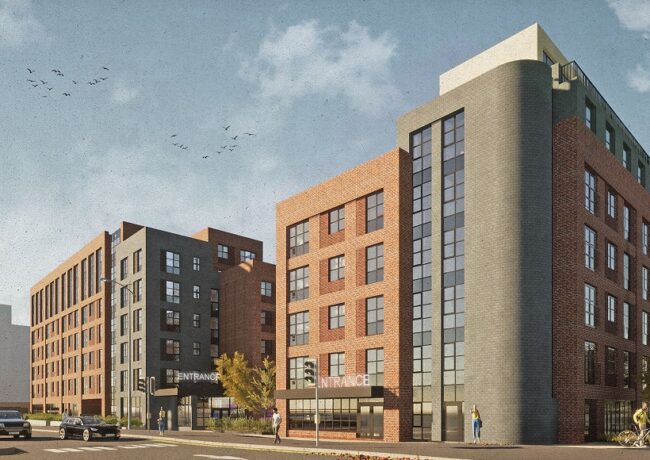Commentary
COMMENT | Rochdale’s pioneering regeneration
Rochdale has an undeniable challenge to reinvent its existing estates into modern and ambitious housing for its residents, writes Nicholas Boys-Smith of Create Streets. In Lower Falinge, a housing society is showing the right vision to meet that challenge.

Nicholas Boys Smith, Create Streets
Rochdale is a town of highs and lows. The highs of the surrounding Pennines, the vertiginous Town Hall, the recently recovered River Roch and the long history of making cloth for the wide world. But lows too. The decades of lost manufacturing capability and twentieth century decline. Persistent unemployment. Boarded-up shops. Central Manchester may be only 15 minutes away but sometimes its urban buzz seems to be decades apart.
For some, Rochdale’s Lower Falinge estate has exemplified these lows. Images of its concrete slabs against ashen skies have illustrated dozens of national media stories about ‘sink estates’ or ‘welfare ghettos.’
For many residents, these clichés are very unfair. One Lower Falinge resident, Ann Doherty, told The Guardian: “Every estate has its problems, no matter where you go, but they always seem to pick on us. We’re just normal people, wanting to get on with each other.” Another complained of the impact on some of his neighbours: “If you tell a vulnerable person enough times that they’re scum, that they live on a sink estate and that they’re thick, eventually it’ll mess with their heads and they’ll start to believe it.”
The neighbourhood does have undeniable challenges. A design that minimises the number of homes with private gardens or safely overlooked public space. Needlessly fast nearby roads that cut it off from neighbours or the adjacent town centre, turning what should be a pleasant five-minute stroll to the beautiful banks of the River Roch into a dash past speeding cars or an unpleasant detour through underpass and tunnel.
Historic Toad Lane should be tying Lower Falinge and Rochdale Town Centre together, with its light-filled St Mary in the Baum and Rochdale Pioneers Museum – the1844 birthplace of the global Co-Operative movement and worth a visit if you’re passing. Instead they are lost on a traffic island, marooned between the wrong end of a 1980s shopping mall and the profound 1960s confusion that it was a good idea to build four lane dual-carriageways into the town centre.
Rethinking Rochdale
The good news is that Rochdale Boroughwide Housing, the tenant and employee co-owned mutual housing society that runs the estate is doing something about it. And they are going about it the right way. Working with residents in conversations and workshops the most popular option voted on was the most ambitious – ‘rethink.’ And it’s a good rethink – that keeps some of the old, restoring ten buildings, but also replaces 15 with traditional blocks, streets, private gardens and terraced homes.
This is the right vision and the right process, for Lower Falinge and for estate regeneration more broadly. Work with residents. Vote on preferences. Build urban blocks with ‘clear backs and fronts.’ Take better advantage of a central location, if you have one so as to provide not just affordable housing but also market housing and mixed use. Particularly exciting at Lower Falinge is the potential to link back to the town centre and hopefully to restore and deploy a nearby historic mill as a workspace, community centre or nursery. Jobs and homes. Heritage and modernity. Lower Falinge will be most succesful if it just weaves itself in with the rest of the town – a real place with strengths and challenges but not a mecca for journalists looking for a ‘sink estate’ to write about.

The estate regeneration proposed by Rochdale Boroughwide Housing
Regeneration won’t be easy. Will the money still be there in a possible age of post-Brexit belt-tightening? Will Rochdale Council have the confidence to ensure the speed-reduction of the fast roads that scar the town centre? Taming them is crucial to the long-term economic success of the town. Will they dare?
Rochdale’s parking policy also seems to contradict Greater Manchester’s aim to promote active travel. The number of cars being required per household is unnecessarily high – demanding more cars than residents currently have – and the spatial consequence of this is undermining a safe and popular urban pattern. How can Rochdale promote car-sharing and more walking?
If Rochdale is to rise again to the prosperity, confidence, energy and pride of its nineteenth century heyday it will need to have good places to work, live and play all jumbled together. Lower Falinge is starting to point the way. How beautiful it would be if Lower Falinge can be a symbol not of decay but of rebirth and if it is a renaissance that local residents have helped design and lead.
Nicholas Boys Smith is the Director of Create Streets and the author of its new report, Pioneering Regeneration, into the regeneration of Lower Falinge.





Central Manchester 15 minutes away? On what! The Space Shuttle?
By Elephant
Residents did NOT vote for the ‘rethink’ option. No vote was held. RBH presented 3 options to residents. Residents were asked if they ‘liked’, ‘disliked’, or felt ‘neutral’ about each option. Residents were not allowed to compare the 3 options and indicate which of the 3 they preferred; residents were only asked whether they liked or disliked each individual option.
Your report is factually inaccurate and extremely misleading. Residents did not participate in any vote. I know this because I am a resident.
I am going to lose my home because RBH want to build a different mix of homes here for some other people to live in. I have no guarantee of a new home that will meet my needs. I certainly did NOT vote for this.
What you perceive as an ‘exciting’ regeneration is going to ruin the lives of people here.
By Vic Haigh
Mr Smith should know that it is possible to walk from the estate into the town centre without having to cross major roads however to get to the banks of the river Roche would be a major achievement considering that the college and the sixth form centre have created fenced car parks along the banks therefore there is and never had been a foot path along the river into the town centre.
By Kath Thomas
Oh and the traffic free routes into the town centre are protected by CCTV cameras. The council and RBH could save a considerable amount of funds by ensuring that these routes are kept clean and well lit.
By Kath Thomas
“I have no guarantee of a new home that will meet my needs.“. Translation: I live in a 2 bed terrace but I’m making out that I ‘need’ a 5 bed mansion with a massive garden and am refusing to budge until I’ve extorted the public purse for as much as I can.
By Cynic
If only the council would be more radical in its approach to the environment then all the excess cars littering the small terraced streets might one day be a thing of the past.
Passing the ideology of walking and car sharing and a plan with more homes in the centre can then pass on to the next generation.
Overpopulation is a concern considering the main highs in this much maligned borough are its green spaces, more homes without considering the long term impact of this is a worrying concept.
By Optimist
The need to address pedestrian links across St Mary’s Way and connect the north of the Town with the main centre has appeared on virtually every regeneration strategy for Rochdale in the past two decades …………….and has been completely ignored, largely for ‘transport’ reasons.
The work that OMI Architects has carried out over the past 5 years at Lower Falinge for RBH has clearly started to tackle the estate’s problems.
The original 500 dwellings are equally divided between one-bedroom and three-bedroom flats. The majority of the one-beds are let to single adults, many of whom have a range of challenging issues. Half of all the flats are accessed from decks with no lift access, making them inappropriate for families with young children. The Bedroom Tax has made the three bedroom flats virtually impossible to let.
The flats themselves are actually not too bad, with decent space standards and facilities. The estate is relatively green with grassed areas and mature trees making it a safe haven for kids to play. Most residents like living there. However, from the outside, most visitors can’t see past the ugly brutalist four-storey concrete-clad structures.
OMI started to tackle the issues at Lower Falinge by firstly selective demolition of the least-popular blocks and integrating a range of new dwellings (family houses and bungalows for elderly and disabled residents). These new structures sit amongst the original blocks and help break down the scale of their concrete neighbours, creating recognisable attractive streets that people now feel safe to use.
The historic Toad Lane has been reinstated and Lower Falinge’s impenetrable perimeter has been opened up to encourage greater permeability through the estate and towards town. The next step surely is to provide a proper pedestrian priority connection with the Town centre.
By Dave McCall
These homes are past their sell-by-date. They need to come down – all of them. As a resident, I was fully informed of the choices and was glad option 3 was decided upon. Here’s to an improved Lower Falinge.
By In The Know